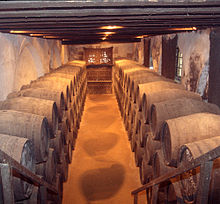
Fortified wine is a wine to which a distilled spirit, usually brandy, has been added. In the course of some centuries, winemakers have developed many different styles of fortified wine, including port, sherry, madeira, Marsala, Commandaria wine, and the aromatised wine vermouth.

Scotch whisky, often simply called whisky or Scotch, is malt whisky or grain whisky made in Scotland.

Whisky or whiskey is a type of liquor made from fermented grain mash. Various grains are used for different varieties, including barley, corn, rye, and wheat. Whisky is typically aged in wooden casks, which are typically made of charred white oak. Uncharred white oak casks previously used for the aging of port, rum or sherry are also sometimes used.
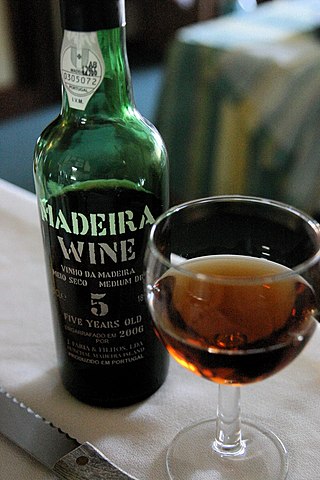
Madeira is a fortified wine made on the Portuguese island of Madeira, in the North Atlantic Ocean. Madeira is produced in a variety of styles ranging from dry wines which can be consumed on their own, as an apéritif, to sweet wines usually consumed with dessert. Cheaper cooking versions are often flavoured with salt and pepper for use in cooking, but these are not fit for consumption as a beverage.
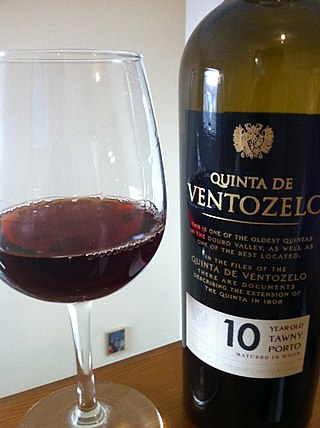
Port wine, or simply port, is a Portuguese fortified wine produced in the Douro Valley of northern Portugal. It is typically a sweet red wine, often served with dessert, although it also comes in dry, semi-dry, and white varieties.
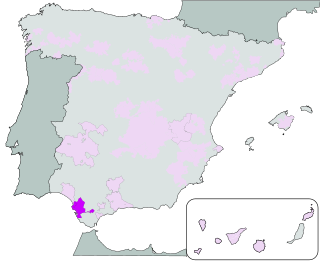
Sherry is a fortified wine made from white grapes that are grown near the city of Jerez de la Frontera in Andalusia, Spain. Sherry is a drink produced in a variety of styles made primarily from the Palomino grape, ranging from light versions similar to white table wines, such as Manzanilla and fino, to darker and heavier versions that have been allowed to oxidise as they age in barrel, such as Amontillado and oloroso. Sweet dessert wines are also made from Pedro Ximénez or Moscatel grapes, and are sometimes blended with Palomino-based sherries.

Single malt whisky is malt whisky from a single distillery.

A barrel or cask is a hollow cylindrical container with a bulging center, longer than it is wide. They are traditionally made of wooden staves and bound by wooden or metal hoops. The word vat is often used for large containers for liquids, usually alcoholic beverages; a small barrel or cask is known as a keg.

Grant's is a blended Scotch whisky, produced by the company William Grant & Sons in Scotland.

Balvenie distillery is a Speyside single malt Scotch whisky distillery located in Dufftown, Scotland. Is owned by William Grant & Sons.
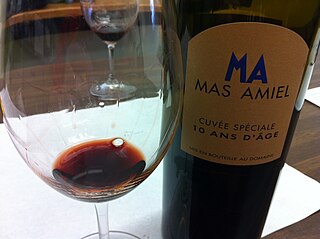
Maury is an Appellation d'Origine Contrôlée (AOC) for fortified vin doux naturel wines made in the Roussillon wine region of France. Almost all wines are red, made from at least 75% Grenache noir (Garnacha). Other permitted grapes are Grenache blanc, Grenache gris, Macabeu (Macabeo), Malvoisie du Roussillon (Tourbat), Syrah, Muscat and other local varieties. Although the grapes are different, they are used and marketed very much like port. It is made in the communes of Maury, Saint-Paul-de-Fenouillet, Lesquerde, Tautavel and Rasiguères. The AOC was granted in 1936.

Mavrodaphni, Mavrodaphne, or Mavrodafni is both a black wine grape indigenous to the Achaea region in Northern Peloponnese, Greece, and the sweet, fortified wine first produced from it by Gustav Clauss in around 1850.

Green Spot is a single pot still Irish whiskey, produced specifically for Mitchell & Son of Dublin by Irish Distillers at the Midleton Distillery in Cork, Ireland. Green Spot is one of the few remaining bonded Irish whiskeys, along with Mitchell's three older offerings, Yellow Spot, Red Spot, and Blue Spot. It is one of only four whiskeys specifically produced for and sold by an independent wine merchant in Ireland.

Tarragona is a Spanish Denominación de Origen Protegida (DOP) for Catalan wines, located in the province of Tarragona and covers two distinct areas: the Camp de Tarragona and the Ribera d'Ebre comarca (district).
Vernaccia di Oristano is a white Italian wine grape variety grown on the island of Sardinia which makes a wide range of wine styles for the Denominazione di origine controllata (DOC) of Vernaccia di Oristano based in the province of Oristano. This includes both dry and sweet wines as well as fortified "sherry-like" wines aged in a solera. The grape has a long history on the island of Sardinia with Sardinians claiming that consuming ample quantities of wine produced from the grape as being responsible for low instances of malaria on the island.

Stranahan's Colorado Whiskey is a 94 proof, small batch whiskey distilled in Denver, Colorado. Stranahan's was the first modern microdistillery to legally make whiskey in Colorado, and an early craft whiskey distiller in the United States.
This glossary of winemaking terms lists some of terms and definitions involved in making wine, fruit wine, and mead.
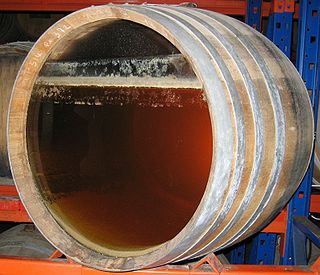
Ullage is a winemaking term that has several meanings but most commonly refers to the headspace of air between wine and the top of the container holding the wine. It can also refer to the process of evaporation that creates the headspace itself or it can be used as a past tense verb to describe a wine barrel or bottle that has gone through the evaporation process. The headspace of air is a mixture mostly of alcohol and water vapors with carbon dioxide that is a by-product of the fermentation process. In containers that are not completely air-tight, oxygen can also seep into this space. While some oxygen is beneficial to the aging process of wine, excessive amounts can lead to oxidation and other various wine faults. This is why wine in the barrels is regularly "topped up" and refilled to the top with wine in order to minimize the head space. In the bottle, the ullage or "fill level" of the wine can be an important indicator of the kind of care and storage conditions that the wine was kept in. After-market resellers and wine auction houses will often inspect the ullage levels of older vintages to determine the potential quality and value of wine.
Blackadder is an independent bottler of single malt Scotch whisky. It was founded in 1995 by Robin Tucek and John Lamond, and named after historic Scottish figure Bishop John Blackadder. The company's bottlings are generally from single casks, are neither chill-filtered nor colored, and are bottled in clear glass to allow customers to see the natural color of the whisky.

A barrel-aged beer is a beer that has been aged for a period of time in a wooden barrel. Typically, these barrels once housed bourbon, whisky, wine, or, to a lesser extent, brandy, sherry, or port. There is a particular tradition of barrel ageing beer in Belgium, notably of lambic beers. The first bourbon barrel-aged beers were produced in the United States in the early 1990s.
